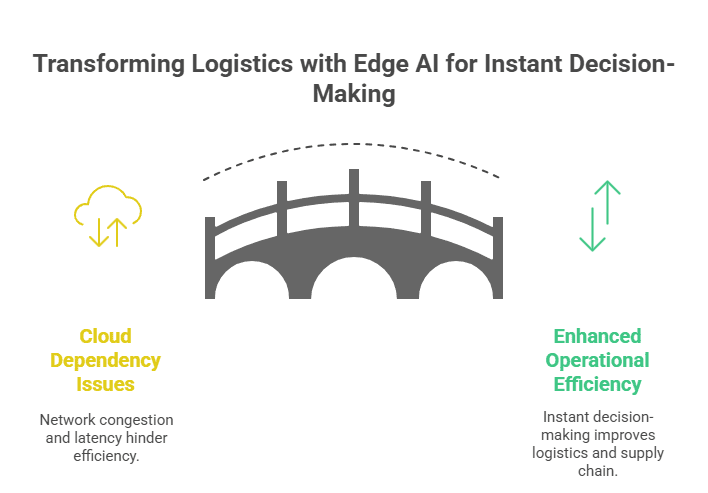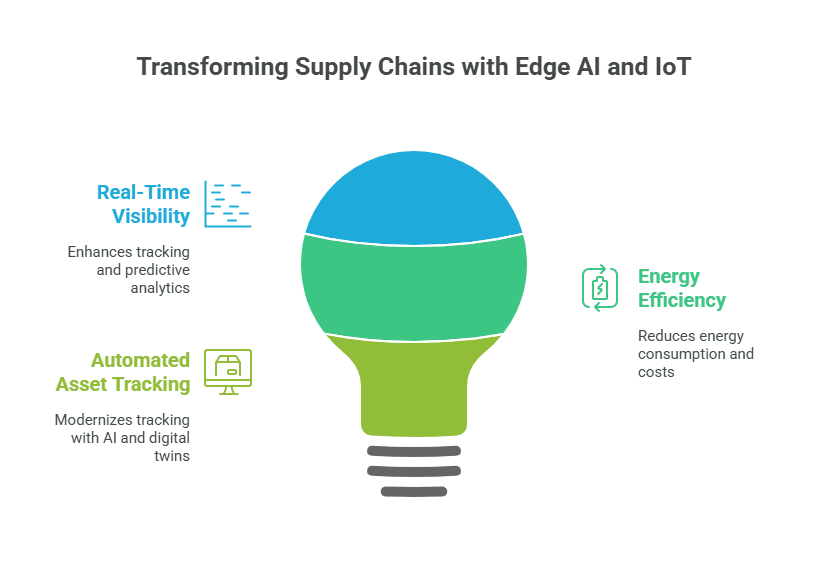How Edge AI is Transforming Logistics and Connected Vehicles in 2025
April 03, 2025Trucks that predict traffic before a jam. Warehouses that optimize inventory autonomously. Drones rerouting mid-flight to dodge storms. This isn’t the future – it’s happening now, powered by Edge AI. Real-time decision-making, the new competitive advantage in logistics, transportation, and supply chain management, is not just theoretical. It's a practical, efficient solution. Yet, relying solely on cloud computing creates bottlenecks – network congestion, latency issues, and expensive bandwidth consumption. Edge AI brings intelligence closer to the action: it processes data locally on IoT devices and enables seamless, instant decision-making without waiting for cloud servers to respond. Let’s consider how Edge AI brings logistics, vehicle-to-everything (V2X) communication, and supply chain resilience to a new level.
Smarter Logistics: Scaling AI Across Global Networks
Modern supply chains operate on razor-thin margins, where efficiency determines profitability. Possessing either excessive inventory or inventory deficits creates obstacles such as blocking capital for business operations and generating additional storage expenses or creating transportation delays and customer dissatisfaction. Choosing optimal inventory levels requires live-time operational enhancements.
Historically, logistics operations relied on centralized cloud computing for data analysis. Many data points that need cloud transmission lead to performance delays and higher expenses as well as network reliability issues for remote facilities and busy distribution areas. Edge AI changes this by processing data locally, allowing immediate, on-site decision-making.
Edge AI in Logistics: How It Works
Instead of waiting for cloud-based analysis, Edge AI-enabled IoT sensors process critical logistics data on-site at key points in the supply chain:
- Warehouses. Continuously monitor stock levels, detect shortages, and prevent overstocking.
- Distribution centers. Analyze temperature changes, motion anomalies, and asset utilization to optimize space and energy use.
- Transport hubs. Forecast delays by analyzing real-time traffic, weather, and cargo conditions.
Edge AI reduces cloud dependency and, therefore, enables instant responses – rerouting shipments, optimizing warehouse stock, and mitigating disruptions.

Real-World Impact
Companies implementing Edge AI in logistics have already seen measurable gains. Through AI-powered vessel loading procedures, P&O Ferrymasters improved supply chain visibility and increased cargo capacity by 10%. AI-driven forecasting helped cut conversion expenses by 20%, with enhanced labor productivity contributing to 70% of these savings.
Scaling AI for Global Operations
Edge AI allows companies to expand AI capabilities efficiently by adopting flexible scaling strategies:
- Horizontal scaling (Deploying additional AI-powered IoT devices as operations grow).
- Vertical scaling (Enhancing processing power to handle complex, high-volume tasks).
- Geographical scaling (Implementing AI solutions across multiple locations while maintaining consistent performance).
You may be interested in: How AI Can Help You Set Up Your IoT Project
This multi-layered approach allows businesses to scale AI-driven logistics seamlessly, improving supply chain resilience and operational efficiency without overwhelming cloud networks. But logistics isn’t the only domain being transformed. In transportation, Edge AI transforms connected vehicles.
The Future of Connected Vehicles: Edge AI Meets V2X
The automotive industry is shifting from mechanical efficiency to intelligent, data-driven mobility. Vehicles are no longer just modes of transport – they are becoming interconnected systems capable of making split-second decisions that enhance safety, efficiency, and driving experience. At the core of this transformation is Vehicle-to-Everything (V2X) communication, a technology that enables vehicles to interact with:
- Other vehicles (V2V): Sharing speed, braking, and location data to prevent collisions.
- Traffic signals and infrastructure (V2I): Adjusting driving behavior based on real-time road conditions.
- Pedestrians and cyclists (V2P): Detecting and responding to vulnerable road users for improved urban safety.
How Edge AI Supercharges V2X
Traditional cloud-based AI processing introduces delays – milliseconds that could mean the difference between an accident and a safe journey. Edge AI eliminates this latency by processing data directly in vehicles, ensuring instant decision-making.
- Collision avoidance: Real-time data analysis helps predict and prevent crashes by detecting potential hazards instantly.
- Adaptive speed control: Vehicles dynamically adjust speed based on traffic flow, road conditions, and weather.
- Predictive maintenance: Onboard sensors monitor brake wear, tire pressure, and engine performance, detecting failures before they happen.
Industrial Vehicles Leading the Charge
While fully autonomous passenger cars are still in development, Edge AI is already transforming industrial vehicles in controlled environments where automation can significantly improve efficiency and safety:
- Warehouses: AI-powered forklifts navigate autonomously, optimizing logistics without human intervention.
- Mines: Autonomous haul trucks operate in hazardous conditions, reducing risks and increasing productivity.
AI Model Training with Synthetic Data
Developing reliable AI for connected vehicles requires extensive training – which would take years with physical testing alone. The virtual environment platform Omniverse from NVIDIA helps Hyundai Motor Group and other companies to speed up this development process by simulating real-world conditions. Artificial intelligence models need virtual environments created with NVIDIA Omniverse for testing purposes as well as optimization procedures before expensive real-world trials begin.
Through edge AI technology, the automotive industry is reaching new heights because self-driving vehicles as well as advanced transportation systems in all sectors now improve safety and enhance operational intelligence. Edge AI transforms logistics systems while it significantly affects the operations of worldwide supply chains.
Strengthening Supply Chains: The Rise of Edge AI + IoT
Since the early 2020s, global supply chains have faced continuous disruptions – pandemics, geopolitical tensions, and climate disasters have exposed vulnerabilities in traditional logistics models. Businesses relying on centralized decision-making are struggling to adapt. The solution? Edge AI and IoT-powered automation. According to MarketsandMarkets, AI in the supply chain market is projected to grow from USD 9.15 billion in 2024 to USD 40.53 billion by 2030, reflecting a compound annual growth rate (CAGR) of 28.2%. So, what backs this growth? Let’s break it down.

Edge AI’s Three Supply Chain Superpowers
Integrating Edge AI trends into supply chains offers transformative advantages:
1. Real-Time Visibility & Predictive Analytics. Traditional tracking systems often fail in low-connectivity environments like remote warehouses or congested ports. Edge AI addresses these challenges by:
- Processing logistics data locally, reducing reliance on cloud connectivity.
- Triggering immediate alerts for temperature fluctuations, shipment delays, and misplaced inventory.
- Utilizing predictive analytics to forecast bottlenecks and prevent disruptions before they occur.
2. Energy Efficiency & Sustainability. The vast amount of data in supply chains can overwhelm cloud networks and waste energy. Edge AI enhances sustainability by:
- Analyzing essential data at the source, thereby reducing bandwidth consumption.
- Powering low-energy smart warehouses leads to decreased electricity use and operational costs.
- Supporting green logistics initiatives by minimizing waste and optimizing fuel efficiency.
3. Automated Asset Tracking with AI & Digital Twins. Traditional tracking methods – such as barcode scans and manual inventory counts – are labor-intensive and prone to errors. Edge AI, combined with computer vision and digital twins, modernizes asset tracking by:
- AI-powered cameras and sensors are employed to track inventory automatically without human intervention.
- Creating real-time digital replicas of warehouse environments to improve accuracy.
- Reducing losses and speeding up inventory reconciliation through automated tracking.
Conclusion
The future of IoT isn’t about collecting more data – it’s about acting on data instantly. Edge AI optimizes IoT – traditional cloud computing has its place, but relying solely on centralized processing creates bottlenecks. Edge AI is the fundamental requirement to achieve industry speed alongside process automation and operational efficiency for applications that need immediate responses. The implementation of smart edge devices sends data to local networks for processing information that leads to both low system latency and immediate decision capability. This shift transforms industries including logistics, transportation, and supply chain management, because any delay, no matter how small, could result in substantial monetary losses.
With Edge AI, organizations can:
- Scale dynamically to handle growing AI demands without performance loss.
- Minimize cloud dependency, reducing costs while improving speed and reliability.
- Enhance automation, allowing IoT systems to react instantly to environmental changes, asset movements, and operational disruptions.
The future isn’t about whether companies will adopt Edge AI – it’s how fast they can scale it. Those who embrace it now will lead the next wave of IoT innovation. Are you ready to bring intelligence to the edge?




